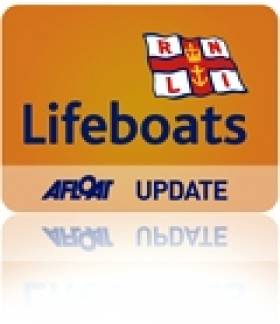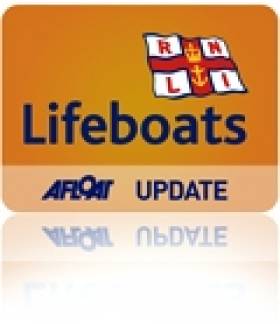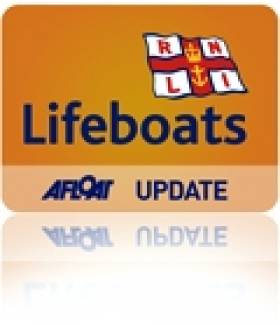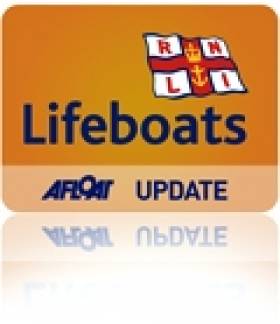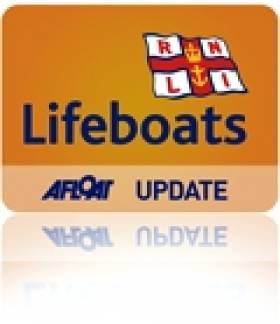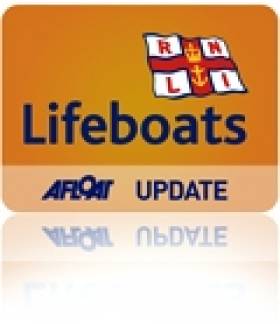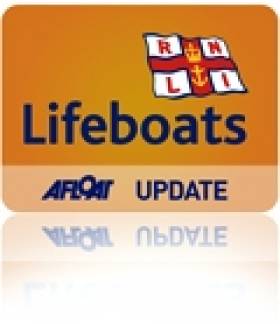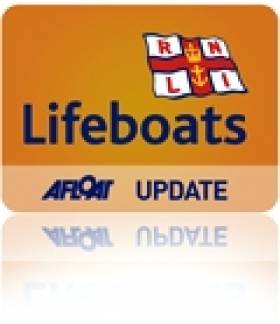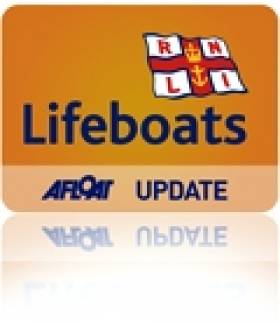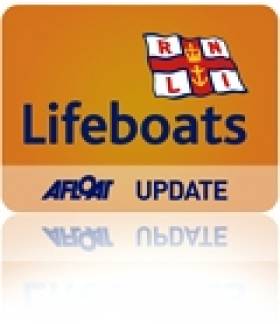Displaying items by tag: RNLI
Lough Ree RNLI To Celebrate First Year of Service
#RNLI - Lough Ree RNLI is celebrating its first year in service and is holding an open day on Saturday 31 August for the public to come and see how the station operates.
The volunteer crew at the station will be on hand to meet and greet people as well as put on a display to show how the inshore lifeboat is launched, some of the exercises it carries out and how it is then recovered.
Lough Ree RNLI lifeboat station in Co Westmeath went into operation on a trial period in July last year and since then has been a busy station, with 14 call-outs in its first six months of operation and a further 24 shouts to date in 2013.
The call-outs have been varied from helping boats that have got into difficulty in rough weather, to helping vessels which have got lost while on the lake day and night, to a boat sinking rapidly after hitting hidden debris in the water.
All RNLI lifeboat stations are run on a volunteer basis and it is through the time and dedication shown by their volunteer crew members that they are able to provide communities, including Lough Ree's, with such a vital search and rescue service.
All at Lough Ree RNLI are looking forward to meeting visitors at the station in Coosan Point on Saturday 31 August between 2pm and 4pm.
Dun Laoghaire RNLI Lifeboat Medevac From Dublin Bay Cruise Liner
#rnli – Dun Laoghaire RNLI lifeboat carried out a medical evacuation to assist an elderly woman from a cruise ship after she became ill on the vessel which was located in Dublin Bay.The volunteer crew was requested to launch their all weather lifeboat, the Anna Livia, at approximately 10pm on Monday night last (19 August) following a report that an elderly woman was reported unwell on the cruise liner.
The crew under Coxswain Mark McGibney, made their way to the scene some four nautical miles away where Dr Sarah Brookes, Dun Laoghaire RNLI Deputy Lifeboat Medical Adviser was then put on board the cruiser and assessed the ill lady. The casualty was brought onboard the lifeboat on a stretcher and transferred to a waiting ambulance once ashore.
Wicklow RNLI Remembers Historical Greystones Lifesaver
#RNLI - Wicklow RNLI travelled to Greystones on Sunday afternoon (18 August) for the unveiling of a plaque in memory of RNLI coxswain John Doyle and two members of his family, who lost their lives in 1892.
The deceased were trying to assist a vessel breaking away from her moorings in Greystones Harbour on 14 October 1892, a Friday night when heavy seas and a north-east gale prevailed in the Irish Sea.
That night, the schooner Mersey, which was moored alongside the jetty at Greystones, threatened to break up where she lay, and the owner resolved to let her drive on the beach.
John Doyle and William Doyle - with Herbert Doyle, son of the latter - went out along the jetty to cast a rope to the vessel and, having done so, were making their return when a great wave suddenly engulfed them. They had often gone out to save life and were famed for their bravery.
John and William Doyle left large families, and there were many tearful eyes at the funeral service in St Patrick's Church for the three Doyles, many of whose descendants are still in Greystones.
The Anchor amusement centre and restaurant at the harbour was originally a lifeboat house, and between 1871 and 1896 there were two lifeboats, the Sarah Tancred and the Richard Brown, the latter of which John Doyle served as coxswain.
As the Wicklow lifeboat entered Greystones, the crew scattered flower petals inside the harbour entrance as a mark of respect for coxswain Doyle.
John Doyle’s granddaughter Betty Lowe unveiled the plaque on the pier wall. During the ceremony, the lifeboat crew presented her with a framed photograph of the Wicklow lifeboat and an RNLI flag.
Lowe was inspired to erect the memorial after attending the unveiling of The Beacon of Hope sculpture in 2009 at the RNLI headquarters in Poole. Her grandfather’s name is one of hundreds on the memorial who have given their lives selflessly to save others over the last 200 years.
Speaking after the ceremony, Wicklow RNLI volunteer lifeboat press officer Tommy Dover said: "We would like to thank Mrs Lowe and her family for inviting us to the ceremony, it was a great privilege to be involved."
Baltimore RNLI Inshore Lifeboat Bring Home Four People (& 2 Dogs!)
#rnli – The Baltimore RNLI inshore lifeboat went to the assistance of a motor cruiser whose engine failed near Horse Island in West Cork this afternoon Tuesday 20th August. The alarm was raised at 15:05 and within minutes the lifeboat was underway. Helm John Kearney and his crew proceeded through the islands of Roaring Water Bay to rendezvous with the stricken vessel which had subsequently anchored between Horse Island and Castle Island.The 6.5m day cruiser whose engine had overheated had a party of 2 men, 2 women and 2 dogs on board at the time and had been on passage from Baltimore to Schull. The lifeboat crew passed a tow to the vessel and took her in tow returning her to her moorings in Baltimore Harbour.
Helm John Kearney commended them for staying calm, he said 'They did everything right, they were wearing life jackets and anchored promptly to secure their safety when her engines failed'.
Helm John Kearney, crew Ger O"Brien and Peter Losberg. Slip crew John O'Flynn, Colin Rochford and Declan Tiernan.
#RNLI - Some 46 people completed the 750m course on Lough Erne in the revived Castle Island Charity Swim recently - including three Enniskillen RNLI lifeboat crew in full kit!
As reported last month on Afloat.ie, the swim traditionally took place annually with the support of the Blake family, and Enniskillen RNLI hailed as a "great honour" the chance to bring back the annual event.
Apart from the action on the water on Sunday 11 August, the day featured was a family fun morning on shore with a bouncy castle, face painting and an ice cream stand.
Lifeboat volunteer crewman Adrian Kelly said of the day: "I would like to take this opportunity to thank everyone who got involved on all levels. I really hope everyone enjoyed the event and that we can give it a go next year."
Video: Bangor RNLI In Canoe Rescue
#RNLI - The RNLI has posted video to YouTube of the Bangor lifeboat crew's rescue of two canoeists from the water at Belfast Lough last Monday 12 August.
The two paddlers were reported to be suffering from the cold and exhaustion but were taken to safety by the Bangor RNLI volunteers.
Skerries RNLI Launches To Flare Sighting Off Balbriggan
#RNLI - Skerries RNLI carried out a search of an area north of Balbriggan on Wednesday night (14 August) after a vessel in the area reported sighting a distress flare.
The volunteer crew launched their inshore lifeboat shortly after 9.30pm with Philip Ferguson as helm and crew members Adam Scott, Stephen Crowley and AJ Hughes on board.
Dublin Coast Guard requested the lifeboat to launch to investigate a report of a distress flare north of Balbriggan Harbour in North Co Dublin.
The lifeboat proceeded directly to the area indicated by the coastguard and conducted an extensive search. Clogherhead RNLI were also tasked and carried out a search further north, while the Skerries Coast Guard unit carried out a search of the coastline in the area.
Just after 10.30pm, the Dublin Coast Guard declared that they were satisfied that a thorough search had been carried out, and with nothing found all units were stood down to return to base.
Speaking after the call-out, Philip Ferguson said: "Conditions were very good on scene and while it was quite a dark night, visibility was reasonably good which helped our search.
"Our volunteer crew are always ready to launch to any sign that somebody is in difficulty at sea and we are happy that on this occasion no lives were in danger."
Wicklow RNLI Lifeboat Diverts From Exercise For Call-Out
#RNLI - Both Wicklow lifeboats were diverted to Brittas Bay last Sunday morning (11 August) while on a routine exercise in the bay.
At 10.57am the Irish Coast Guard tasked the lifeboats to investigate a report of a small motor boat with two people drifting off the beach.
A member of the public had raised the alarm, as they believed the occupants might be in need of assistance.
As the lifeboats were proceeding to the small boat, they were stood down by the coastguard after it was ascertained that the two people were fine and able to return to shore under their own power.
The lifeboats then resumed exercise in the Wicklow bay area.
Speaking after the incident, Wicklow RNLI volunteer lifeboat press officer Tommy Dover said: "This was volunteer crew member Alan Goucher’s first call-out as a helm in charge of the inshore lifeboat and Connie O'Gara’s first call-out on the all-weather lifeboat as a mechanic."
Howth RNLI Open Day Hailed A Great Success
#RNLI - Howth RNLI lifeboat station held an open day last Sunday 11 August, welcoming a great number of locals and visitors who came to see the station, explore the lifeboats and meet the crew.
The children in particular enjoyed meeting Stormy Stan and taking part in fun competitions.
Everyone got the opportunity to get aboard the lifeboats and find out more about the lifesaving work carried out by the volunteer crew members.
The Sea Safety Team was also on hand to give advice about lifejackets and safety precautions at sea. Howth RNLI depends on the generous support of the local community to help save lives at sea.
The same weekend as the open day, the volunteer lifeboat crew was involved in three rescues in a single 24-hour period, bringing 11 people to safety.
Double Launch For Holyhead RNLI To Two Separate Incidents
#RNLI - Holyhead RNLI volunteers were called to launch two lifeboats at the same time during two different incidents on Anglesey in North Wales yesterday 12 August.
Holyhead RNLI relief lifeboat 17-38 and volunteer crew responded to a Pan Pan (communication of an urgent situation onboard) in the Irish Sea just over three miles north-west of Holyhead.
The vessel, a 15m motor launch with five people on board, had lost all steering. Vessels near by stood until the lifeboat arrived, and the boat was taken under tow to Holyhead Marina.
At the same time, the Holyhead inshore lifeboat was launched to three people struggling in the sea off Penrhos beach area.
When the volunteer crew arrived, the three had made it to land but a child in the group was looking very unwell. The RNLI crew wrapped him up to keep warm until ambulance arrived.
In the meantime, an air ambulance was requested and landed at Stanley Hospital nearby to take the casualty for treatment. Holyhead's local coastguard team were also in attendance.



























